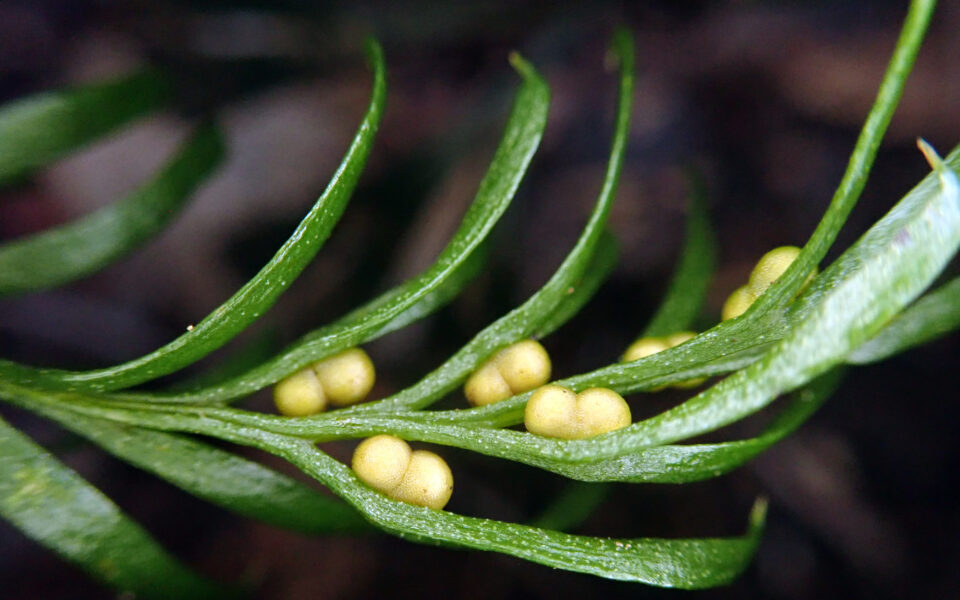Scientists find the largest known genome inside a small plant

BOTANIC Last year, Jaume Pellicer led a team of fellow scientists into a forest on Grande Terre, an island east of Australia. They were in search of a fern called Tmesipteris oblanceolata. Standing just a few inches tall, it was not easy to find on the forest floor.
“It doesn’t catch the eye,” said Pellicer, who works at the Botanical Institute of Barcelona in Spain. “You would probably step on it and not even realize it.”
The scientists eventually managed to spot the nondescript fern. When Pellicer and his colleagues studied it in the lab, they discovered it held an extraordinary secret. Tmesipteris oblanceolata has the largest known genome on Earth. As the researchers described in a study published Friday, the fern’s cells contain more than 50 times as much DNA as ours do.
If you find it strange that such a humble plant has such a gigantic genome, scientists do, too. The enigma emerged in the 1950s, when biologists discovered that the double helix of DNA encodes genes. Each gene consists of a series of genetic letters, and our cells read those letters to make corresponding proteins.
Scientists assumed that humans and other complex species must make a lot of different proteins and therefore have bigger genomes. But when they weighed the DNA in different animals, they discovered they were wildly wrong. Frogs, salamanders and lungfish had far bigger genomes than humans did.
It turns out that genomes are much weirder than scientists had expected. We carry about 20,000 protein-coding genes, for example, but they make up only 1.5% of the 3 billion pairs of letters in our genome.
Another 9% or so is made up of stretches of DNA that don’t encode proteins but still carry out important jobs. Some of them, for example, act like switches to turn neighboring genes on and off.
The other 90% of the human genome has no known function. Some scientists have an affectionate nickname for this vast quantity of mysterious DNA: junk.
Some species have little junk DNA, whereas others have staggering amounts. The African lungfish, for example, has about the same number of protein-coding genes as we do, but they are scattered in a giant genome that totals 40 billion pairs of DNA letters — 13 times as much DNA as our own genome holds.
In the early 2000s, when Pellicer trained as a botanist, he was intrigued to learn that a few lineages of plants have massive genomes as well. Onions, for example, have a genome five times as large as ours.
In 2010, when Pellicer began working at Kew Gardens in London, he got the chance to study a family of plants known as bunchflowers, which were known to have big genomes. He spent months mincing leaves with a razor blade, isolating cells from dozens of species and weighing their DNA.
When he weighed the genome of a plant called Paris japonica, which grows in the mountains near Nagano, Japan, he was shocked at the result. The ordinary flower had a genome containing 148 billion pairs of letters — a world record.
In the years that followed, colleagues sent him fresh samples of ferns from Australia and New Zealand to chop up. He discovered that those plants, too, had massive genomes, although not quite as big as that of Paris japonica.
Pellicer knew that related fern species grew on a few Pacific islands. In 2016, he began making plans for an expedition to Grande Terre, part of the archipelago known as New Caledonia.
It wasn’t until 2023 that he finally made it to the island. He collected a number of species along with a team that included colleagues from Kew, his graduate student Pol Fernández and local plant experts.
Back in Barcelona, Fernández was startled to discover that Tmesipteris oblanceolata’s genome contained about 160 billion pairs of DNA letters. Thirteen years after Pellicer had discovered a record-breaking genome, his graduate student was also experiencing the thrill of breaking the record.
There are two chief ways in which genomes expand over evolutionary time. Many species carry virus-like stretches of DNA. As they make new copies of their genomes, they sometimes accidentally make an extra copy of that viral stretch. Over many generations, a species can accumulate thousands of new copies, causing its genome to swell.
It’s also possible for a species to suddenly end up with two genomes instead of one. One way for an extra genome can arise is for two closely related species to mate. Their hybrid offspring may inherit full sets of DNA from both parents.
Pellicer and his colleagues suspect that a combination of virus-like DNA and duplicated genomes is responsible for the huge amount of genetic material in Tmesipteris oblanceolata. But they don’t know why this humble fern ended up with a record-setting genome while other species — like us — have so much less DNA.
It’s possible that most species gradually accumulate DNA in their genomes without suffering any harm. “A lot of biology is ‘why not?’ rather than ‘why?’” said Julie Blommaert, a genomicist at the New Zealand Institute for Plant and Food Research who was not involved in the new study. Eventually, however, genomes may get so big that they become a burden. Cells may have to expand to house all the extra DNA. They










